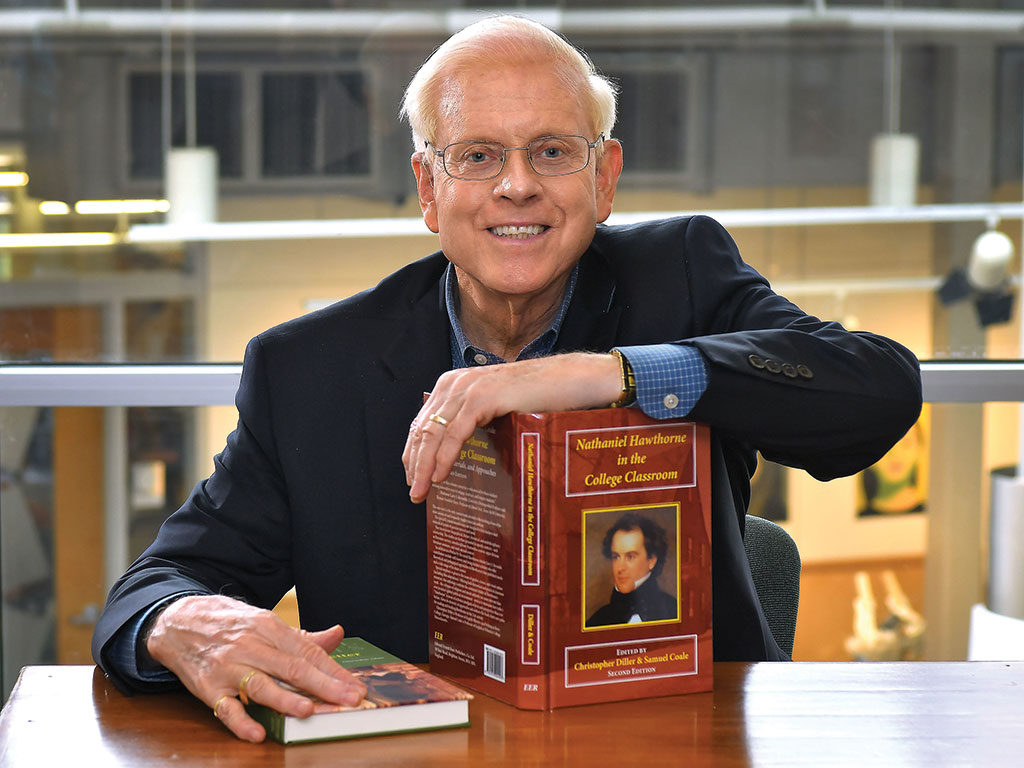‘A’ is for obsessed

Professor Coale fascinated by Scarlet Letter author
Professor of English Samuel Coale has been fixated on the work of Nathaniel Hawthorne since childhood and recently co-edited Nathaniel Hawthorne in the College Classroom (Brighton: Edward Everett Publishers, 2018), which taps into his expertise. In June, Coale delivered his paper “Whose Woods These Are, I Think I Know: Japanese Forest-Bathing and Hawthorne’s Haunted Forests” at the International Poe and Hawthorne Conference in Kyoto, Japan, and was presented with an award for his work on Hawthorne and support of The Nathaniel Hawthorne Society. We have a few questions.
Tell us about this obsession with Nathaniel Hawthorne. When did it start and with what book?
I first discovered a mustached Hawthorne in the card game “Authors” at my grandmother’s house and thought that the scarlet letter was a letter you mailed, dripping in blood. In high school I loved The Scarlet Letter’s complexities, contradictions, conspiracies, secrets and its aura of inevitability and doom, just as I had in “Macbeth.” I was hooked with its Greek-tragic framework.
What is so fascinating about him and his work?
His style appears decorous, elegant and polite, but it’s riddled with ambiguities and paradoxes, so that the end of a single paragraph can undermine its opening statements. This plus his psychological probing into “The Haunted Mind,” and the clash between conscious and unconscious motives, between a character’s intended plans and his or her hidden compulsions, fascinated me, as do all Gothic tales and novels.
How does your fascination manifest itself in your work here at Wheaton and elsewhere?
Teaching Hawthorne has gone on for years, and having written four books on him, I easily ease my research into my classes. Hawthorne’s perspectives have infiltrated all of my teaching and research from DeLillo to Didion with their postmodern obsessions with conspiracy theory, paranoia, the labyrinthine depths of the human mind and plots that twist and turn unexpectedly but maintain that Greek sense of doom and inevitability throughout.
What are the secrets to teaching Hawthorne?
Helping students get past the “bland” style and pointing out what he’s really up to. The style is not “juiced up.” It can be dull, essayistic and analytical, and it’s all too easy to just ride across it and miss the darker depths and suggestions. You have to pause, scrutinize and look closely, a process that works well for reading and trying to understand all texts.
What do you hope Wheaton students get out of his work?
All of the above, plus his awareness of “the persecuting spirit” that underscores much of American culture and vision from witch hunts to contemporary pursuits of scapegoats.
If you had to pick one book to recommend, which one would it be and why?
The Scarlet Letter is perfect: well-balanced, veined with secrets and secret confessions, revealing the intricate interplay between the individual and society: each infects the other; neither is “pure.” His later books don’t quite pull off the same extraordinary balancing act, though several short stories do just that.
